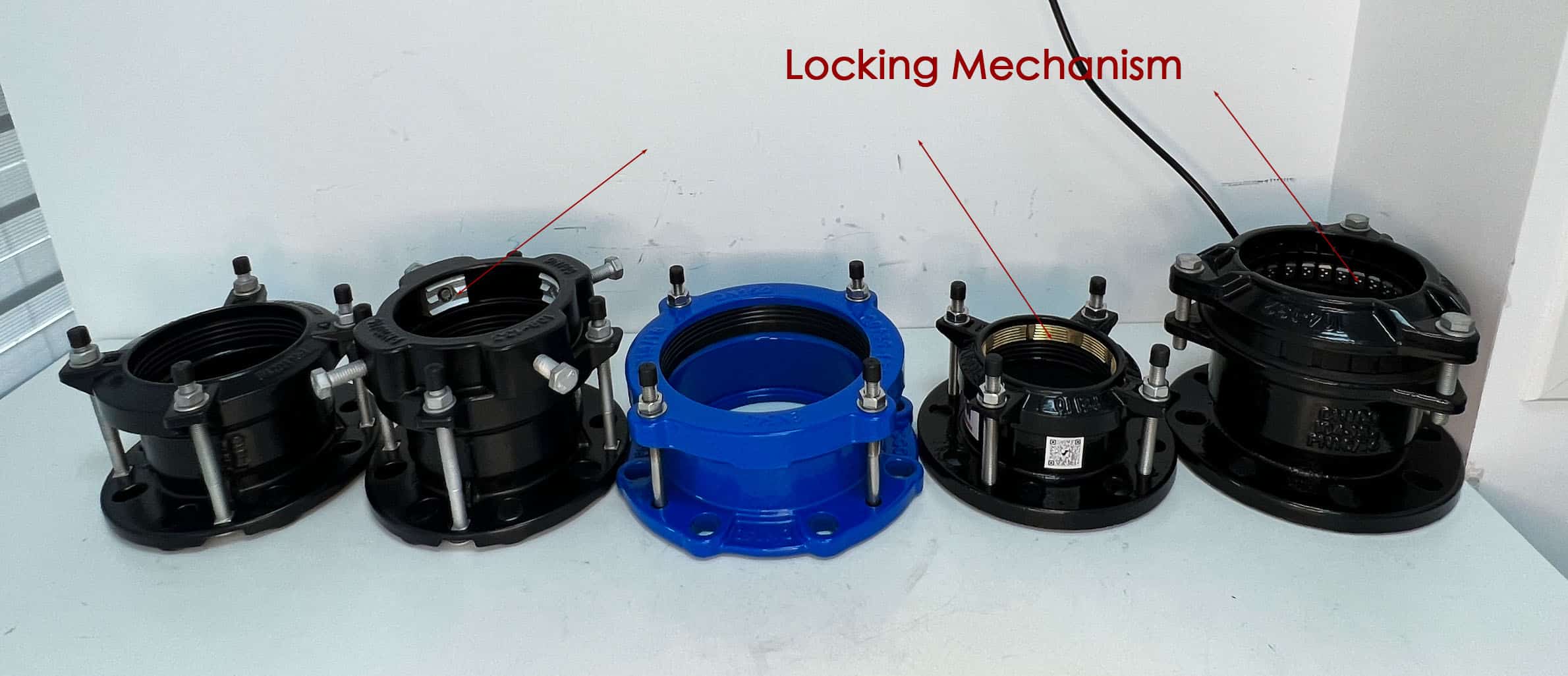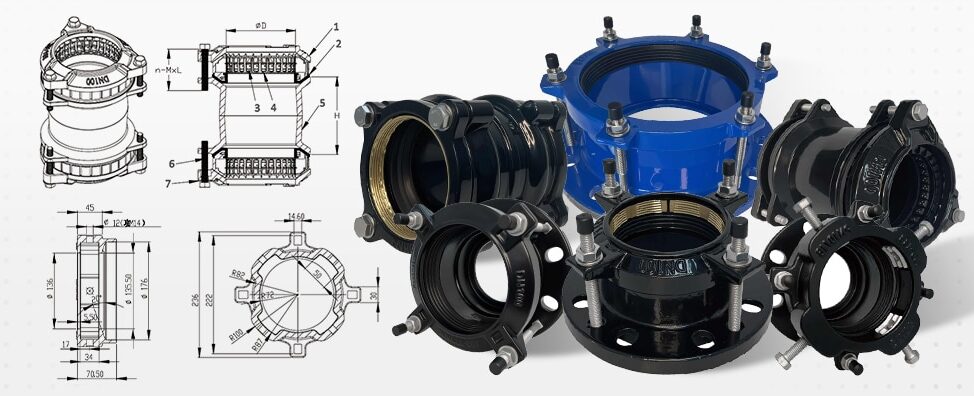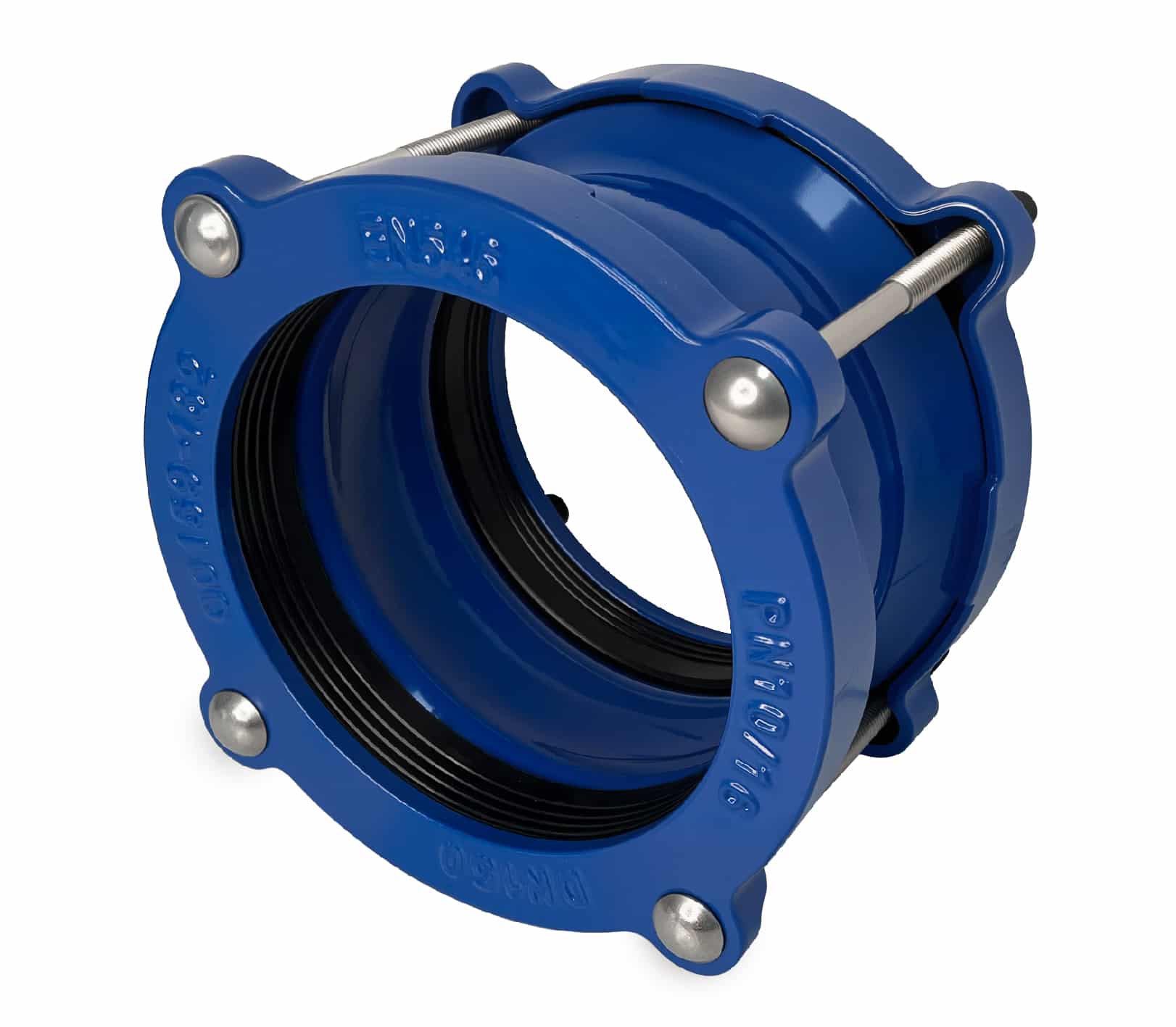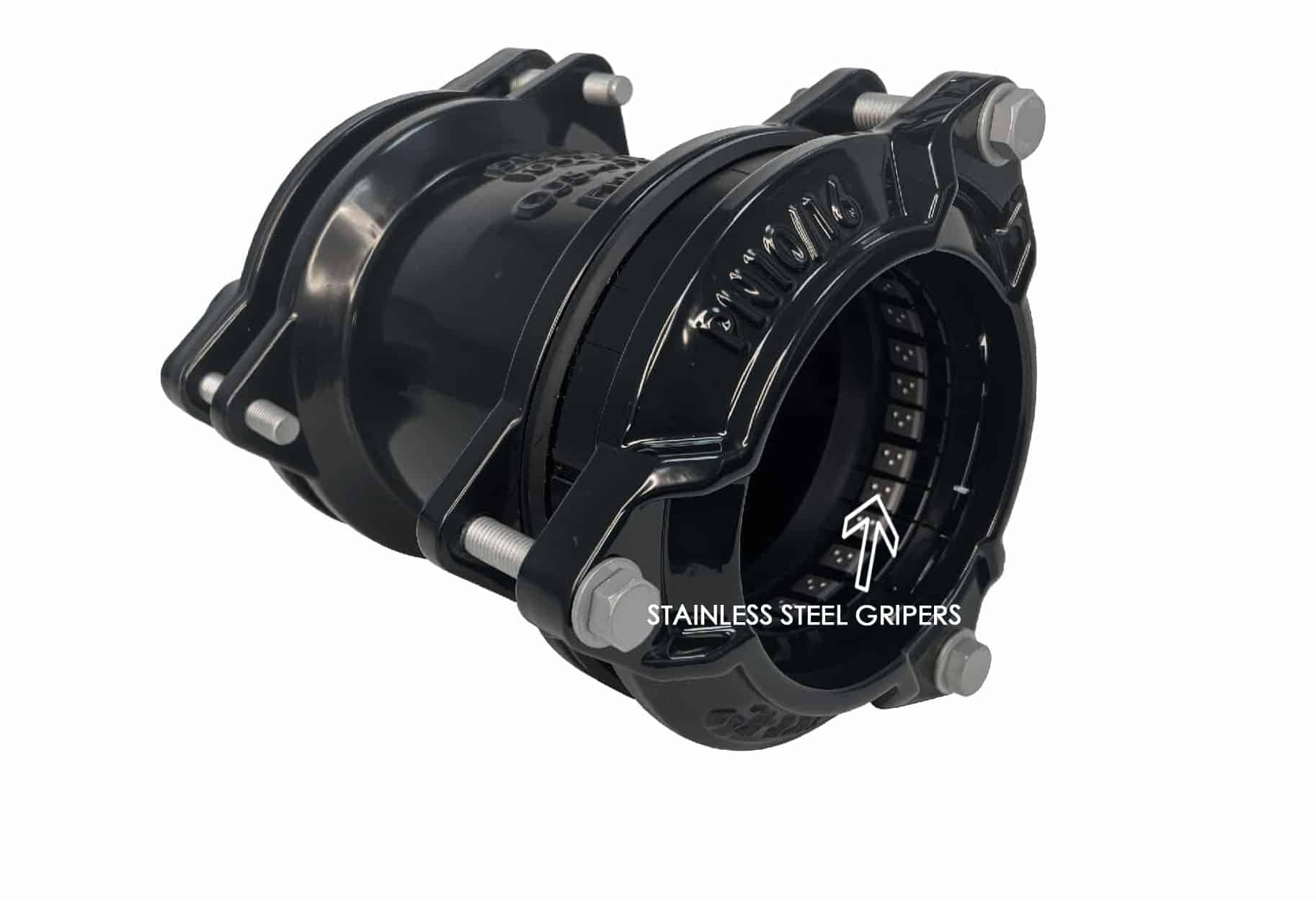Pipe coupling is a short fitting that connects two pieces of pipe in a straight line. It’s used to extend pipe length, change materials, or repair damaged sections. Couplings can be permanent or removable, depending on the type.
It works by:
Inserting the pipe ends into the coupling body
Sealing with gaskets, threads, welding, or compression
Holding firmly using bolts, clamps, or locking mechanisms
Select Right Coupling
1,You need to know the right pipe outside diameter, you can measure as below steps
Remove any rust, paint, or dirt from the pipe surface to ensure accurate measurement
Wrap the tape around the pipe and divide the circumference by π (3.14) to get the OD or use a vernier caliper directly for more accurate results
Make sure to measure from the outer edge to outer edge, not the inner diameter (ID)
Wide range couplings are made for a range of OD (e.g., 108–118 mm), make sure your pipe’s OD is within the coupling’s range.Dedicated couplings are made for specific pipe outside diameter, you can compare the marked pipe outside diameter with the actually measured pipe OD, they should be same or no more than 1mm difference.
Never assume based on “nominal size.” For example, a “DN100” steel pipe may have a different OD than a “DN100” HDPE pipe. Always measure the actual OD
2,You need to check the pipe thickness
For high-strength pipes like ductile iron pipes, steel pipes, asbestos cement (AC) pipes, and PVC pipes, the standard wall thickness is generally enough to install and use couplings properly. However, when working with HDPE pipes, you need to pay special attention.
HDPE pipes come in different wall thickness grades (SDR levels), and they are more prone to deformation due to temperature changes and ground settlement. Therefore, when connecting HDPE pipes, it is important to use pipe couplings with a locking mechanism.

For SDR 11 and above (thinner walls), it is highly recommended to use an internal stiffener. For SDR 13.6, SDR 17, SDR 21, SDR 26, and SDR 33, which are even thinner, a stiffener is required. Thin-walled HDPE pipes can easily deform under the tightening force during coupling installation. The stainless steel stiffener provides internal support, helping prevent leakage or pipe pullout, and ensures proper sealing and joint stability.
For thicker pipes like SDR 7.4 or SDR 9, you may not need an internal stiffener in low-tension applications, but you should still evaluate the need for a stiffener based on the pipe coupling manufacturer’s guidelines or the specific pressure conditions.
3,Pay attention to pipe tolerance
First, you need to know the tolerance range of the pipe you are using, and then you need to select a pipe coupling that is suitable for that tolerance range. To know the tolerance range of the pipe, you need to ask the pipe manufacturer, because the tolerance can vary depending on the pipe material and the design standard used.
Pipe tolerances refer to the allowable deviation in pipe dimensions (such as outside diameter (OD), wall thickness, roundness, and straightness) from the nominal values specified by manufacturing standards. These tolerances are typically defined by standards like ASTM, EN, ISO, or AWWA.
Common pipe tolerances include:
Outside diameter tolerance: ±0.5% to ±1.0% of the nominal size, depending on the pipe material and standard.
Ovality (out-of-roundness): The difference between the maximum and minimum diameters at a cross-section.
Wall thickness tolerance: Critical for pressure-bearing capacity and insert compatibility.
Pipe Tolerance affect coupling performance
1, Sealing Reliability
Couplings, especially mechanical couplings, rely on compressing gaskets around the OD of the pipe to create a leak-proof seal.
If the OD of the pipe is outside the tolerance range the coupling was designed for, the gasket may not compress evenly, causing leaks or blowouts.
2, Grip Strength
Restraint couplings use some sort of gripping mechanism (wedges, teeth, rings) to hold the pipe in place.
If the pipe is out of round or has a different diameter, the coupling may not grip the pipe properly, causing it to slip under pressure or create uneven stress.
3, Installation
If the tolerances are too tight, you may have a hard time getting the coupling on the pipe, requiring extra force or potentially damaging the coupling.
If the fit is too loose, the pipe may be misaligned, not seal properly, or be unstable under pressure.
Therefore, when we design pipe couplings at Judberd, we have a large tolerance range. For example, for a DN100 wide range coupling, our design range is 109-128mm. However, even if the customer’s pipe is 108 mm or 129mm, our coupling will work fine.
4,Pay attention to pipeline working pressure
Working pressure in the pipeline is an important factor that affects the design of the pipe coupling.
Higher pressure means more internal force pushing against the gasket.The coupling design must make sure the gasket compresses evenly to prevent leaks.High-pressure couplings often have multiple gaskets, longer sealing lengths, or conical sealing surfaces for added reliability.
The body and bolts of the coupling have to be able to handle the hoop stress from the pressure in the pipeline.So for high pressure pipe line, coupling body should be thicker, more numbers bolts and higher grade of bolts, and Reinforcement rings or stiffening rib should be added for the necessary part of the pipe coupling body.
Under high pressure, the pipe ends want to pull out.High-pressure pipeline couplings need to have strong mechanical grip systems like:brass, steel or high strength plastic grip rings or Wedge-type locking mechanisms
High-pressure designs need higher safety factors, typically 1.5 time of the rated working pressure.This affects both material selection and dimensional design.
5,Pay Attention to Pipeline Temperature
High Temperature pipeline
For Steam lines, chemical processing, hot water systems etc high temperature pipe line, Metal fatigue and strength reduction, At high temperatures, materials like carbon steel may lose strength. Stainless steel (e.g., SS316 or SS310) or alloys like Inconel may be more suitable.
Different materials expand differently; couplings must accommodate thermal movement without leakage.
Standard rubber gaskets (like EPDM) may degrade at high temps. Use Viton or silicone rubber for better heat resistance.
Low Temperature Pipeline
For Cryogenic lines, outdoor water systems in cold climates etc pipeline etc, Some metals, like cast iron, become brittle at low temps. Ductile iron or low-temperature carbon steel is preferred.
Gaskets must remain flexible in cold; EPDM and nitrile rubber (NBR) with proper low-temp ratings are commonly used.
If water in the pipe freezes, it can expand and crack rigid couplings. Flexible couplings or ones with built-in expansion allowances are ideal.
Temperature Swing Pipeline
For Lines exposed to day-night cycles or seasonal variation etc pipeline, Repeated expansion and contraction can stress couplings.
Use flexible couplings or designs with thermal compensation.Gasket materials must endure repeated stress and maintain sealing integrity.You need to choose Flexible couplings with restrained designs or Thermal expansion joints if necessary
6,Pay Attention to media in pipeline
For Drinking Water, the most important consideration is Safety, corrosion resistance, non-toxic materials, so you need to choose Ductile iron (with WRAS, NSF etc non-toxic certified poxy coating) or stainless steel (SS304/316)body , EPDM gasket(approved for drinking water), avoid materials that may release lead, zinc, or other contaminants.
For Saltwater with high corrosion from chlorides, you need to choose SS316L, duplex stainless steel, or corrosion-resistant alloys material for coupling body, EPDM or FKM (Viton) gasket depending on temperature, Heavy-duty epoxy, rubber lining, or ebonite lining fo r coupling body surface protection, avoid carbon steel or poorly coated ductile iron—rapid corrosion risk.
For Oil , it is easier for chemical compatibility and fire resistance, so you need choose carbon steel or stainless steel material for coupling body depending on pressure and corrosion risk, choose NBR (nitrile rubber) gasket– excellent oil resistance , and Anti-corrosion paint, oil-resistant inner linings if needed
For Gas , Most important is Gas tightness and non-permeability, for coupling body material ,you can choose carbon steel, ductile iron or stainless steel,For Gasket, you can choose NBR (gas resistant) or FKM for high-temp gas, and use restrained couplings for pressurized gas lines. For gas pipeline, Leak-proof sealing and pressure testing are critical.
For Chemicals, Most important is Chemical compatibility with metal and rubber, For coupling body, you can choose Stainless steel (SS316) or specialized alloys, For Gasket, you can choose Viton (FKM), PTFE, or other chemical-resistant elastomers, For Coating, please consider rubber lining or polymer coatings inside the coupling, always check chemical compatibility charts before finalizing.
For Slurry, Most important is abrasion, sediment buildup , for coupling body, you can choose ductile iron with wear-resistant paint, for gasket, you can choose EPDM or PU-lining for abrasion resistance.
7,Pay Attention to coupling coating
The surface coating of a pipe coupling is influenced not only by the characteristics of the pipeline medium but also by the installation environment. For example, the commonly used FBE coating includes epoxy powder and polyester powder types.
If your pipe coupling is used underground, you should select epoxy powder. This is because epoxy powder provides excellent corrosion resistance. It forms a dense coating with strong waterproof, moisture-proof, and chemical resistance properties, making it ideal for humid, chemically aggressive underground environments. In addition, epoxy powder has strong adhesion to steel and other substrates, ensuring it does not peel off easily during long-term burial. Since there is no sunlight exposure underground, UV resistance is not required — and given that epoxy’s main weakness is poor UV resistance, it actually becomes the most suitable choice for underground use.
If your pipe coupling is installed above ground and exposed to sunlight, you should not use epoxy powder due to its poor UV resistance. Instead, you should use polyester powder. Polyester powder has outstanding UV resistance and excellent light aging properties — it will not chalk, fade, or crack under sunlight like epoxy. It also offers good outdoor weatherability, being able to withstand sun exposure, rain, and temperature fluctuations, making it ideal for outdoor pipe couplings. Moreover, polyester powder has a high-gloss finish and long-lasting color, making it suitable for visible installations where appearance matters.
For other types of surface coatings, you must also consider the installation environment, and you should not generalize your selection. You should carefully review the product specifications provided by the powder or paint manufacturer to choose the most appropriate option. You can also consult Judberd to receive professional guidance tailored to your needs.
8, Recommendations for selecting pipe couplings for several common types of pipelines
1, Pipeline coupling solutions for municipal water supply
For municipal water supply pipelines, the working pressure is generally not very high and usually does not exceed PN25. Therefore, the preferred choice is a corrosion-resistant ductile iron body with a surface coated with FBE coating certified for drinking water. The gasket should be made of EPDM material that is also certified for drinking water use. Bolts can be made of carbon steel in grade 4.8, 6.8, or 8.8, with surface treatments such as Dacromet or hot-dip galvanizing for rust protection
Pipe coupling for municipal water supply
2, How to connect pipelines in fire protection systems
For fire protection systems, steel pipes are commonly used. The ends of these steel pipes are often machined or rolled to create standard grooves. For grooved pipe ends, you can use groove couplings for quick connection. The body of the groove coupling is made of ductile iron, coated with a bright red FBE coating. The gasket material is EPDM, and the coupling comes with bolts in grade 4.8, 6.8, or 8.8. However, it’s important to note that for fire protection systems, the pipe coupling must have UL/FM certification, and the product must be clearly marked with the UL/FM label and certification number.
3, Pipeline connection for irrigation systems
For irrigation systems, since the pipeline pressure is low and drinking water certification is not required, plastic material can be used for the coupling body, or bitumen-coated cast iron can be selected as the coupling body. The gasket should be made of EPDM, and the bolts can be carbon steel in grade 4.8, 6.8, or 8.8 with Dacromet coating.
4, Applications of Stainless Steel couplings in shipbuilding
In the shipbuilding industry, you need flexible couplings for the ship’s water supply and drainage systems. The industry requires that pipe couplings be certified by recognized classification societies. You must pressure test them to four times the working pressure.
Because ships operate in saltwater environments, the materials you use must have excellent resistance to saltwater corrosion. So, the coupling body is typically made of stainless steel (like SS316), and the rubber gaskets are made from marine-grade rubber, such as EPDM or NBR with protective coating.
For applications where the pipe may move, the coupling must have excellent axial, lateral, and angular compensation to handle the ship’s vibrations and thermal expansion. The product must seal for a long time, have fatigue resistance, and not leak while the ship is operating or on long voyages.
Because ships have limited space, the design must be compact and allow for quick installation and removal. For the shipbuilding industry, Judberd offers the following two types of pipe couplings to choose from:
5, Couplings for pipeline systems with high vibration
1, For pipeline systems with high vibration, it’s especially important to select flexible couplings with anti-pullout features. One type of anti-pullout design, as shown in the picture below, involves welding a raised collar onto the pipe and using long tie rods to secure both ends to prevent axial movement of the pipes. However, this solution only works with pipe materials that allow such modifications, such as steel pipe or ductile iron pipe. It doesn’t work with materials like PVC, PE, or GRP that are difficult to modify.
Also, welding collars onto the pipe requires precise coordination with the coupling dimensions and can be time-consuming and labor-intensive.
Alternatively, anti-pullout designs can incorporate built-in components like a grip ring or wedge, as shown below, that lock onto the pipe and prevent the pipe from moving or pulling out because of vibration.
With Grip Ring Design
With Grip Wedge Design
2, Also, for pipeline systems with high vibration, you need a fatigue-resistant design with high-strength.
The coupling body and bolts need to be made of high-strength materials, and the design needs to be able to handle repeated mechanical stress changes.
3, For pipeline systems with high vibration, you need to use flexible couplings with axial, angular, and lateral flexibility. This design will allow the couplings to move a little bit when the pipe vibrates and will reduce the stress on the connection points.
4, For pipeline systems with high vibration, the rubber gaskets need to be made from fatigue-resistant and vibration-resistant materials, like high-quality EPDM or NBR, to make sure they seal well for a long time and don’t get damaged or come loose because of all the vibration.
6, Couplings for underground drainage systems
When you’re choosing a pipe coupling for underground drainage systems, you need to think about the special characteristics of these systems, like being underground, being wet all the time, being at risk of corrosion, and being hard to install.
You should use a flexible, watertight coupling for underground drainage systems. The coupling should be able to move back and forth, side to side, and twist a little bit to handle the ground settling or the pipe moving around.
The body of the coupling should be made of ductile iron or carbon steel, but the surface needs to be treated with anti-corrosion coatings, like FBE coating (if you use FBE, make sure it’s an epoxy powder that’s moisture-resistant, not a polyester powder), epoxy paint, or other protective paints. The bolts should be made of carbon steel with a Dacromet coating to make them more resistant to corrosion.
For HDPE drainage pipes, you should use couplings with locking mechanisms, and you should put stainless steel stiffeners inside the thin pipes to keep them from getting squished or pulled out(for which HDPE pipes need stainless steel stiffeners, please refer to how to connect HDPE pipes). The gasket should be made of EPDM, which is really good at not getting old and not getting hurt by acid or alkali.
Even though drainage systems aren’t pressurized, you still need the couplings to seal well so that the water doesn’t leak out and overflow and make the groundwater dirty.
You should use couplings with wide sealing surfaces. Because different pipe materials (like concrete, PVC, HDPE) have different outside diameters, you need to pick the right coupling based on the actual outside diameter of the pipe to make sure it fits.
Because there’s not much room to work underground, the coupling should be small, easy to put together, and not need any special tools.
You should use couplings that you can put together and take apart quickly so that you can work on them later.
Because it’s really wet and hard to work underground, the couplings need to be able to fight off corrosion and not get old so that the system will last a long time.
You should use products that are supposed to last more than 20 years, and you should ask the manufacturer for test reports or certificates from a third party.
In short, pipe couplings for underground drainage systems need to be flexible connectors that seal well, fight off corrosion, are easy to put together, and work with all kinds of pipes. You should talk to Judberd’s smart design team to get a special coupling or pick the right one based on the kind of pipe you have, the size of the pipe, how much it can be off, how deep it’s buried, and the weather where you live to make sure the connection system will work for a long time.
Pipe coupling for underground drainage systems
Installation
1, Pick the Right Coupling for Your Job
Make sure the coupling material matches the pipe material and is good for whatever you’re putting through the pipe (like water, gas, chemicals).
Make sure the coupling can fit the pipe’s actual outside diameter.
Use couplings with good gaskets (like EPDM, NBR) that are right for what you’re doing.
Make sure the coupling can handle the pressure of the system you’re putting it in, plus a little extra.
2, Check Your Pipes and Couplings Before You Put Them Together
Make sure the ends of the pipes are round, clean, and don’t have any sharp edges, dents, or dings.
Make sure the place where the gasket is going to touch is clean and doesn’t have any dirt, rust, oil, paint, or sharp edges.
Make sure the gaskets, bolts, and sleeves are in good shape. Make sure the gasket is in the groove or housing the right way.
3. Clean and Get the Place Where the Gasket Will Touch Ready
Use a wire brush or a clean rag to get rid of anything that shouldn’t be there.
If you’re using metal pipes, put something on there to keep them from getting rusty if you need to.
If you’re using plastic pipes, make sure they’re smooth and don’t have any scratches that will mess up the gasket.
4. Put the Gasket in the Right Place
Make sure the gasket is in the middle of the pipe’s outside diameter.
If you have a coupling with two gaskets, make sure they both touch the pipe the same way and don’t twist or fold when you put them together.
5. Tighten the Bolts Evenly and in a Diagonal Pattern
Tighten the bolts a little at a time and in a crisscross pattern.
Tighten the bolts a little bit at a time (like 30% → 60% → 100% of the way).
Use a torque wrench to get the bolts to the right tightness (look at the directions that come with the coupling).
If you don’t tighten the bolts enough or you tighten them too much, the gasket will squish out or not squish enough.
6. Put Stiffeners Inside the Pipe (If You Need To)
If you’re using HDPE pipes that are thin, put stainless steel stiffeners inside the pipes to keep them from getting squished by the gasket.
This is important to keep the pipe round and keep the gasket touching the pipe.
7. Test the Pressure
After you put the pipes together, fill them up with water and see if they leak. Put the water in the pipes at 1.5 times the pressure the pipes will have water in them (or whatever the plan says).
Look to see if the water leaks out or the pressure goes down in 15–30 minutes.
8. Think About Where You’re Putting the Couplings
If you’re putting the couplings in the ground or in the water, use coatings that keep the couplings from getting rusty (like FBE, epoxy) and bolts that are really good stainless steel (like SS316).
If the pipes are going to shake a lot, use couplings that won’t let the pipes come apart or get tired.
By following these steps and working with good companies like Judberd, you can be sure that your pipe couplings will work great and not leak for a long time.
For different coupling installation steps, please refer below links
If you need installation manual for other types pipe couplings, contact Judberd directly.











